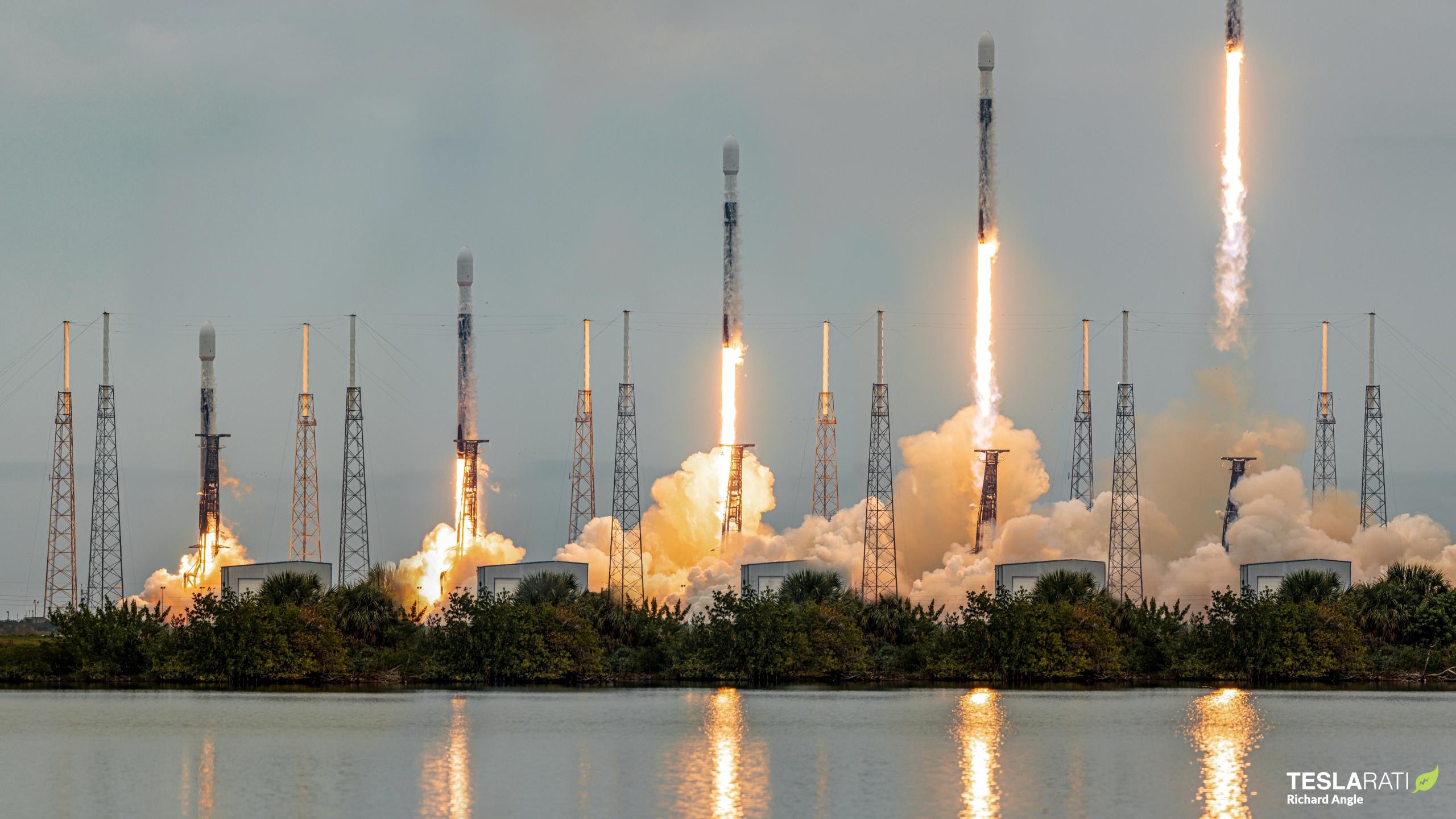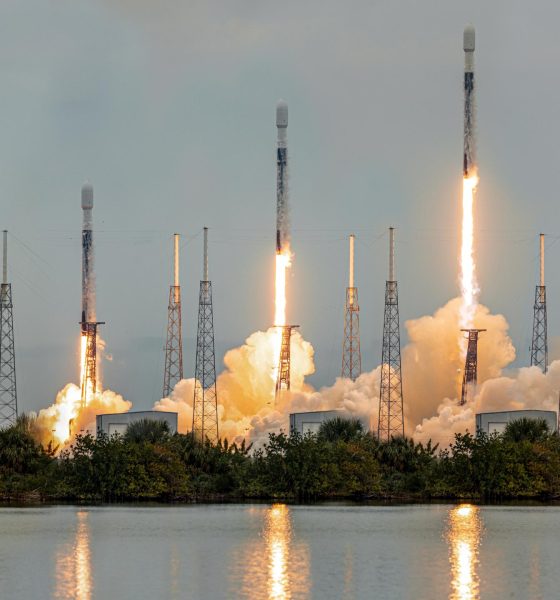

News
SpaceX aces 12th launch of 2022, delivering dozens of satellites to orbit
SpaceX has aced its 12th launch of 2022 just a day over three months into the year, demonstrating a major leap in sustained launch cadence as the company strives to achieve ambitious goals set by CEO Elon Musk.
That 12th launch was Transporter-4, a dedicated rideshare mission managed by SpaceX itself. Falcon 9 lifted off on time on April 1st with fewer satellites than it had ever launched before on a Transporter mission – ‘just’ 40 payloads for about a dozen customers. The rocket performed as expected, reaching a parking orbit about nine minutes after liftoff. Booster B1061 – flying for the eighth time – safely landed on drone ship Just Read The Instructions (JRTI) about a minute prior, ensuring that it will be able to fly again. Over the course of more than 90 minutes, Falcon 9’s upper stage performed four separate burns to deploy all 40 payloads into several different orbits before finally deorbiting itself.
All told, Transporter-4 was SpaceX’s 121st consecutively successful launch, 37th consecutively successful landing, 112th landing overall, 89th reuse of a Falcon booster, and the 34th launch with a reused Falcon fairing. Falcon 9 is and continues to be the most reliable operational launch vehicle in the world. Just as importantly, it’s also the most prolific launch vehicle operational today.
In 2021, SpaceX successfully launched Falcon 9 31 times, falling a bit short of internal goals. Just before the year was over, though, SpaceX abruptly demonstrated the ability to complete five orbital launches in less than three weeks and six launches in less than four weeks – blowing its previous records out of the water and establishing the potential for huge increases in annual cadence. In 2022, SpaceX has thus far managed to sustain a similar cadence for a full quarter of the year.

Following Transporter-4, SpaceX has launched 12 Falcon 9 rockets in 90 days. If sustained for three more quarters, the company could launch 48 times this year – a 55% increase in annual launch cadence compared to a record 31 launches completed in 2021. A few weeks ago, SpaceX CEO Elon Musk established 52 launches – one per week – as the company’s overarching goal for 2022. More recently, Musk – in classic fashion – raised his already significant ambitions and boosted that goal to 60 launches, including at least a thousand more Starlink satellites.
52 launches may still be achievable with a few five or six-launch months. 60 launches, however, would require an average of 5.3 launches per month for the rest of 2022 – maybe not impossible but a huge challenge even before considering the fact that one of SpaceX’s three Falcon pads could be bogged down with as many as five Falcon Heavy and seven Dragon launches in the next nine months. Falcon Heavy, Falcon 9 Dragon, and Falcon 9 Fairing launches all require significant modifications to pad hardware, modifications that likely take at least a week or two to complete. Continuously swapping between setups to squeeze in the odd Starlink or satellite launch isn’t out of the question, but the added schedule risk would increase the odds of delays for several of SpaceX’s most delay-averse missions, including Crew Dragon, Cargo Dragon, and interplanetary spacecraft launches for NASA and two or three ‘national security’ missions for the US military.
Even if SpaceX falls short of Musk’s ambitious 60-launch target, it will take a minor disaster for 2022 to not be the company’s most spectacular year yet. This month alone, SpaceX is scheduled to launch the first all-private astronaut mission to the International Space Station no earlier than (NET) April 6th, followed by launches of Starlink 4-14 NET April 14th, NROL-85 NET April 15th, and a group of four NASA and ESA astronauts NET April 20th.

Elon Musk
Elon Musk just said some crazy stuff about the Tesla Roadster

Elon Musk appeared on the Moonshots podcast with Peter Diamandis today to discuss AGI, U.S. vs. China, Tesla, and some other interesting topics, but there was some discussion about the upcoming unveiling of the Roadster, the company’s electric supercar that will arrive several years after it was initially slated for release.
Musk made some pretty amazing claims about the Roadster; we already know it is supposed to be lightning-fast and could even hover, if Tesla gets everything to happen the way it wants to. However, the car has some pretty crazy capabilities, some of which have not even been revealed.
On the podcast, Musk said:
“This is not a…safety is not the main goal. If you buy a Ferrari, safety is not the number one goal. I say, if safety is your number one goal, do not buy the Roadster…We’ll aspire not to kill anyone in this car. It’ll be the best of the last of the human-driven cars. The best of the last.”
🚨 Elon on the Roadster unveiling, scheduled for April 1:
— TESLARATI (@Teslarati) January 6, 2026
Musk makes a good point: people who buy expensive sports cars with ridiculous top speeds and acceleration rates do not buy them to be safe. They hope they are safe in case of an emergency or crash, but safety is not at the forefront of their thoughts, because nobody buys a car thinking they’ll crash it.
The Roadster is truly going to push the limits and capabilities of passenger vehicles; there’s no doubt about that. Tesla plans to show off the new version car for the first time on April 1, and Musk has only hinted at what is possible with it.
Musk said back in November:
“Whether it’s good or bad, it will be unforgettable. My friend Peter Thiel once reflected that the future was supposed to have flying cars, but we don’t have flying cars. I think if Peter wants a flying car, he should be able to buy one…I think it has a shot at being the most memorable product unveiling ever. [It will be unveiled] hopefully before the end of the year. You know, we need to make sure that it works. This is some crazy technology in this car. Let’s just put it this way: if you took all the James Bond cars and combined them, it’s crazier than that.”
Production is set to begin between 12 and 18 months after the unveiling, which would put the car out sometime in 2027. Hopefully, Tesla is able to stay on track with the scheduling of the Roadster; many people have been waiting a long time for it.
News
Tesla launches hiring for Robotaxi program in its twentieth country
Overall, the hiring signals Tesla’s aggressive timeline for global dominance in autonomous mobility.

Tesla has launched a hiring initiative for its Robotaxi program in its twentieth country, as the company posted two new jobs in Thailand this week.
Tesla is hiring in Bangkok and Kowloon for the Vehicle Operator position, which is related to data collection, and is the first in Thailand, but the twentieth country overall, as the company tries to expand into other markets.
🚨 BREAKING: Tesla is hiring additional full-time Vehicle Operators in Bangkok, Thailand.
Previous openings were 6-month, part-time roles. These are equivalent to AI Safety Operator roles in the U.S. pic.twitter.com/R6LzoU1bos— Tesla Yoda (@teslayoda) January 5, 2026
Tesla has had active job postings for Vehicle Operator positions in the United States, India, Israel, Taiwan, Germany, the Czech Republic, Hungary, the UK, Finland, Switzerland, Sweden, the Netherlands, Austria, Spain, Norway, Italy, and Turkey in past listings.
These postings are not all currently available, likely because the roles have been filled.
Thailand is the most recent, and broadens the company’s potential path to expanding its ride-hailing program, which is only active in the United States in Austin, Texas, and the California Bay Area, so far.
These roles typically involve data collection, which assists in improving Autopilot and Full Self-Driving operation. Tesla’s self-driving programs utilize real-world data that is accumulated and stored, observing vehicle and traffic behavior, as well as tendencies that are performed by human drivers to help increase safety and overall performance.
Overall, the hiring signals Tesla’s aggressive timeline for global dominance in autonomous mobility. Although the company has several high-profile rivals and competitors in the field, it has established itself as a main player and a leader in the development of autonomous technology, especially in the U.S., as its FSD suite is refined on almost a weekly basis.
The Full Self-Driving suite is available in seven countries and territories currently, including the U.S., Canada, China, Mexico, Puerto Rico, Australia, and New Zealand. Its biggest goal for expansion is currently the European market, where regulatory hurdles have been the main bottleneck prolonging its launch on the continent.
Tesla has performed months of testing in various European countries, including France and Spain, and does have support in some areas from various regulatory agencies. However, the company is hoping to get through this red tape and offer its suite in Europe for the first time, hopefully this year.
News
Tesla China rolls out Model Y upgrades, launches low-interest financing
These strategies are aimed at improving the ownership experience and keeping vehicle pricing competitive in the world’s largest electric vehicle market.

Tesla has rolled out minor updates to the five-seat Model Y in China, upgrading the vehicle’s center display to a higher-resolution 16-inch 2K screen. The electric vehicle maker also introduced attractive financing options, including 7-year low-interest rates, to offset the new purchase tax on EVs.
These strategies are aimed at improving the ownership experience and keeping vehicle pricing competitive in the world’s largest electric vehicle market.
Five-seat Model Y gets larger, better display
With its recent update, all three variants of the five-seat Model Y now feature an upgraded 16-inch 2K resolution center display, which replaces the vehicle’s previous 15.4-inch 1080p panel. This screen was already used in the six-seat Model Y L, and it offered improved visual clarity. Tesla China has also updated the Model Y’s headliner to black, giving the vehicle a sleeker appearance.
Prices of the five-seat Model Y remain unchanged at RMB 263,500, RMB 288,500, and RMB 313,500 for the respective trims. This update enhances the cabin experience as domestic rivals are already adopting high-resolution screens. As noted in a CNEV Post report, some domestic automakers have begun rolling out vehicles equipped with 3K-resolution displays.
New financing offers
Tesla also launched ultra-long-term financing offers for its locally produced models in China, which include the Model 3 sedan, the five-seat Model Y, and the six-seat Model Y L, through January 31, 2026. The 7-year option features an annualized fee rate as low as 0.5%, which is equivalent to 0.98% interest. This is expected to save customers up to RMB 33,479 ($4,790) compared to standard rates.
A 5-year zero-interest plan is also available, and it has been extended to the Tesla Model Y L for the first time. These incentives help offset China’s new 5% purchase tax on New Energy Vehicles (NEVs) in 2026-2027. Some of Tesla’s rivals in China have announced in recent months that they would be covering the purchase tax owed by buyers early this year.








